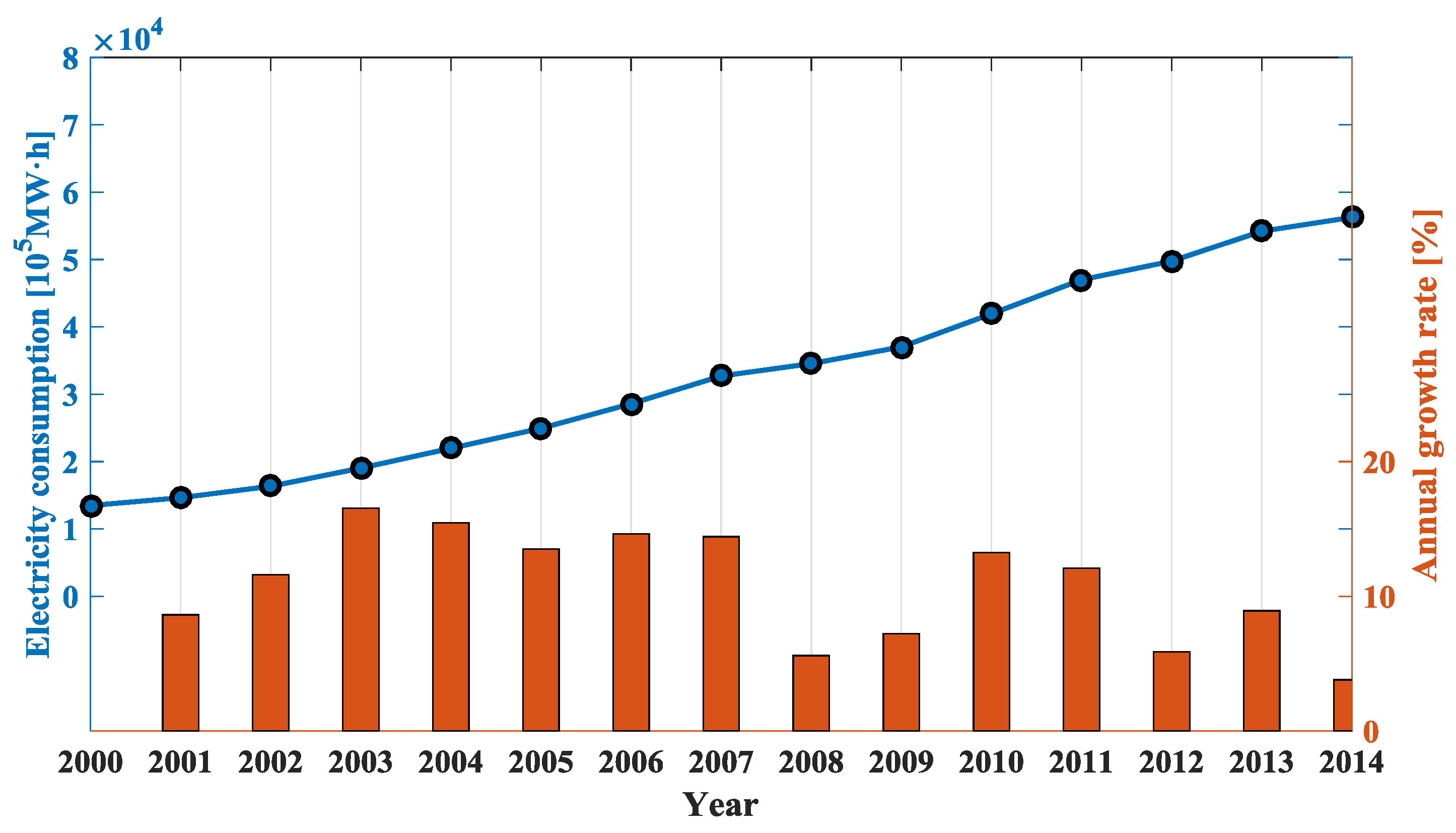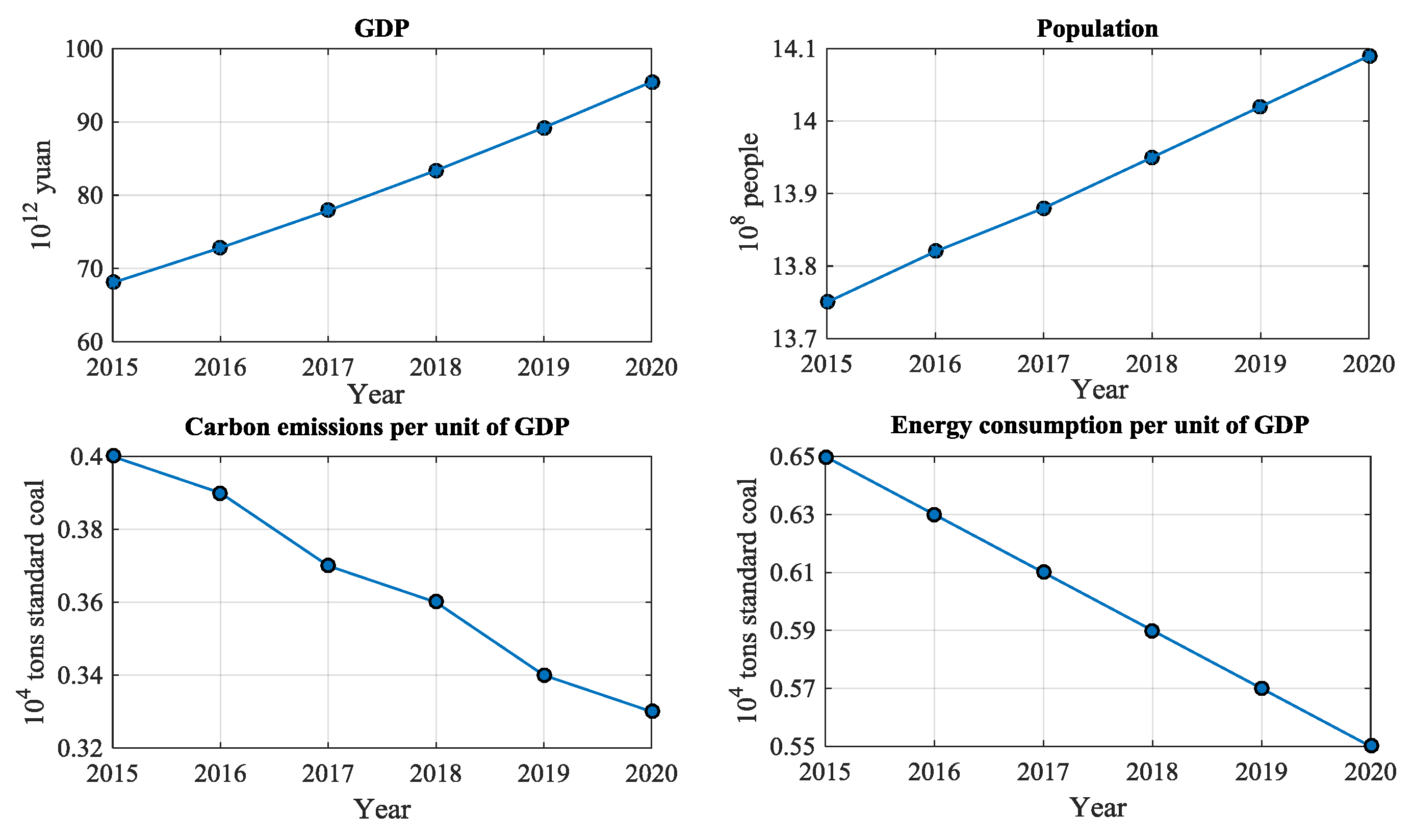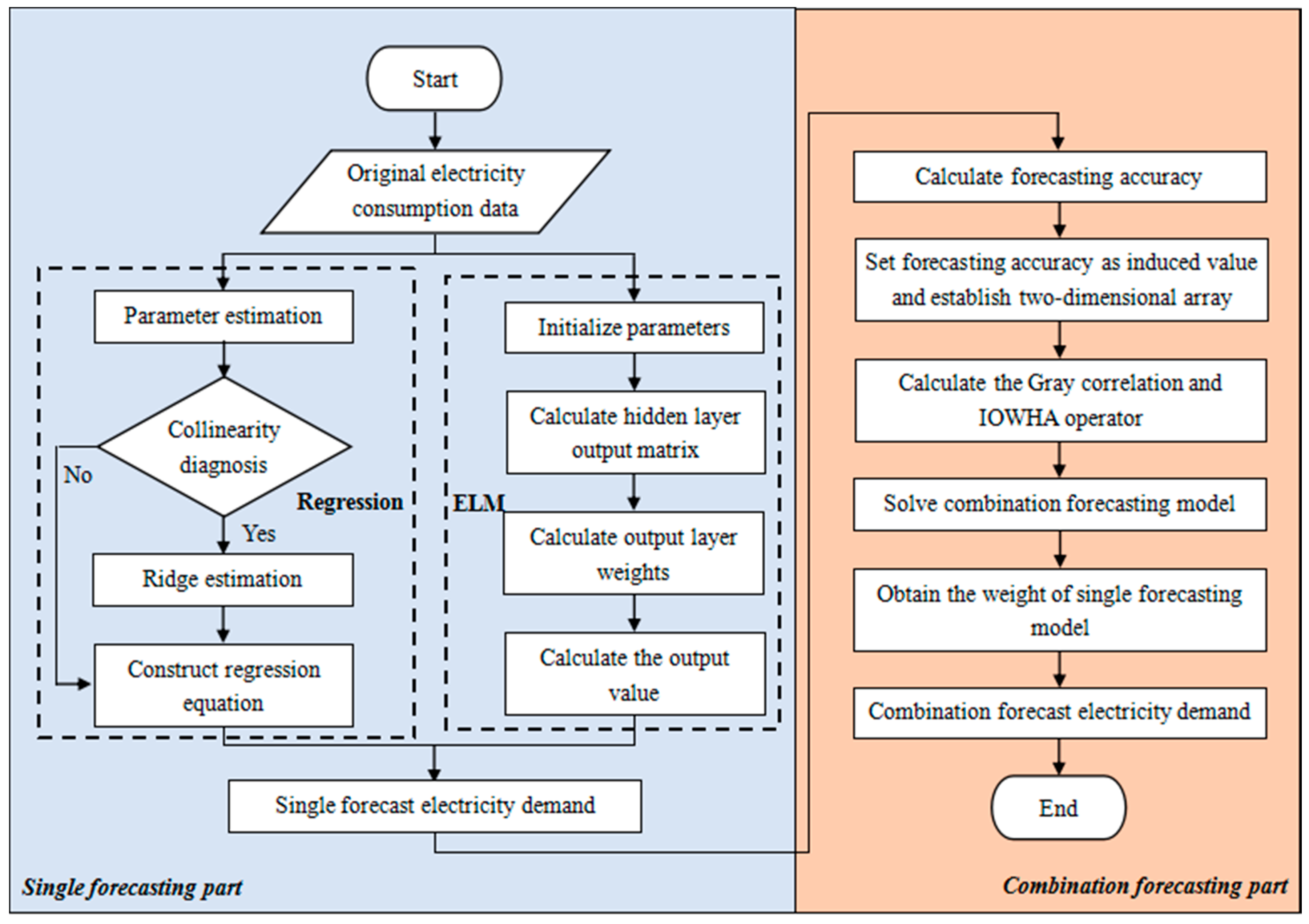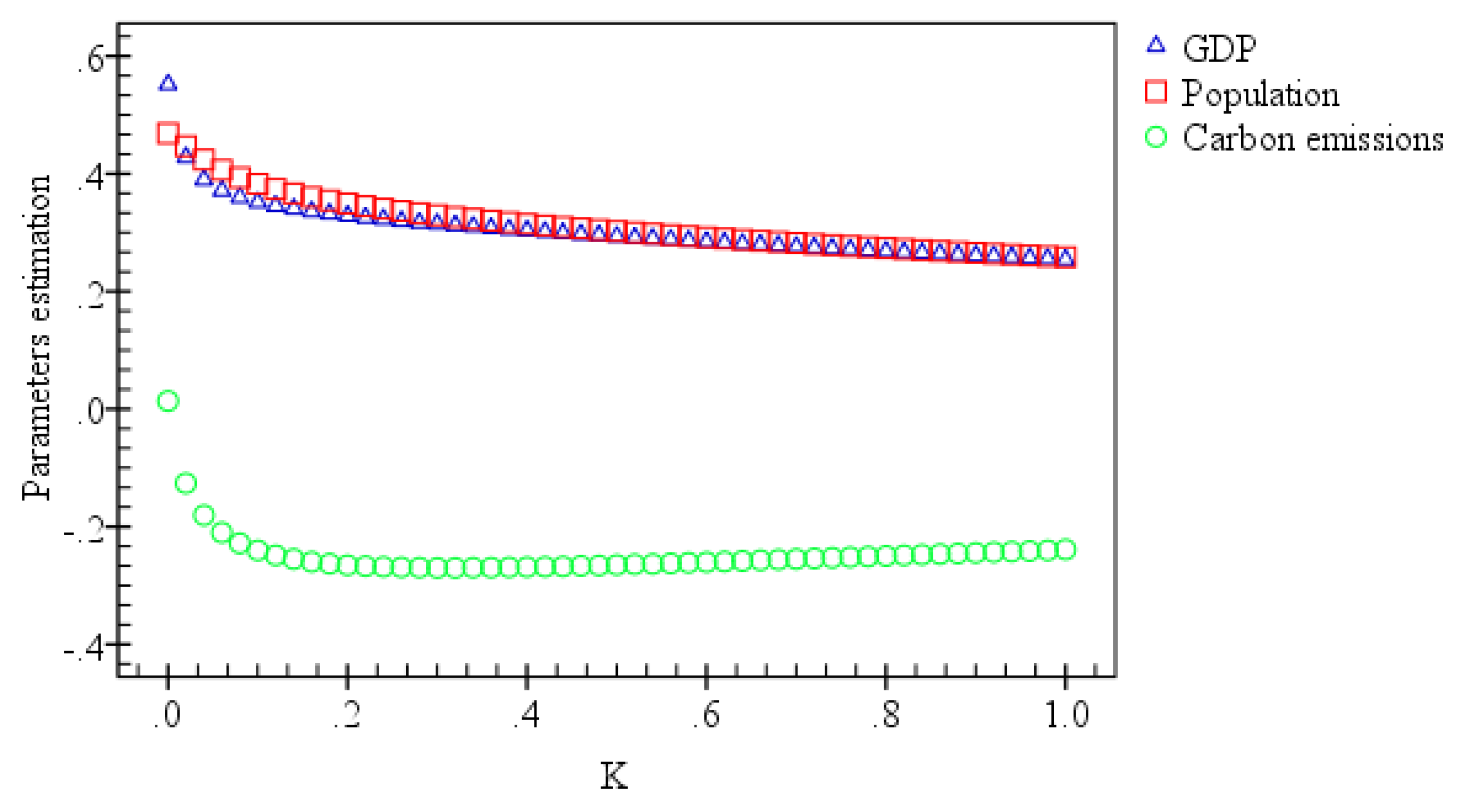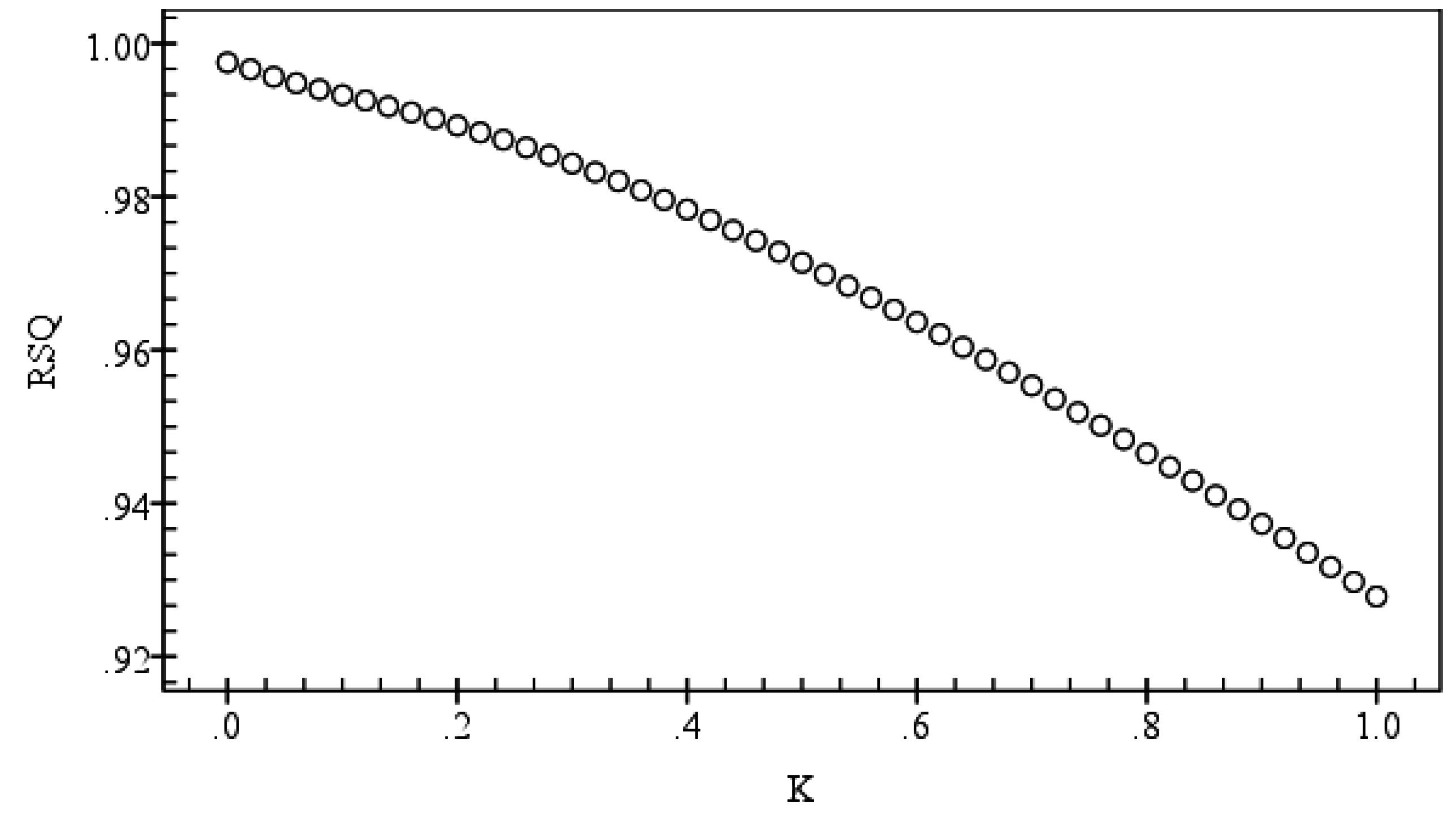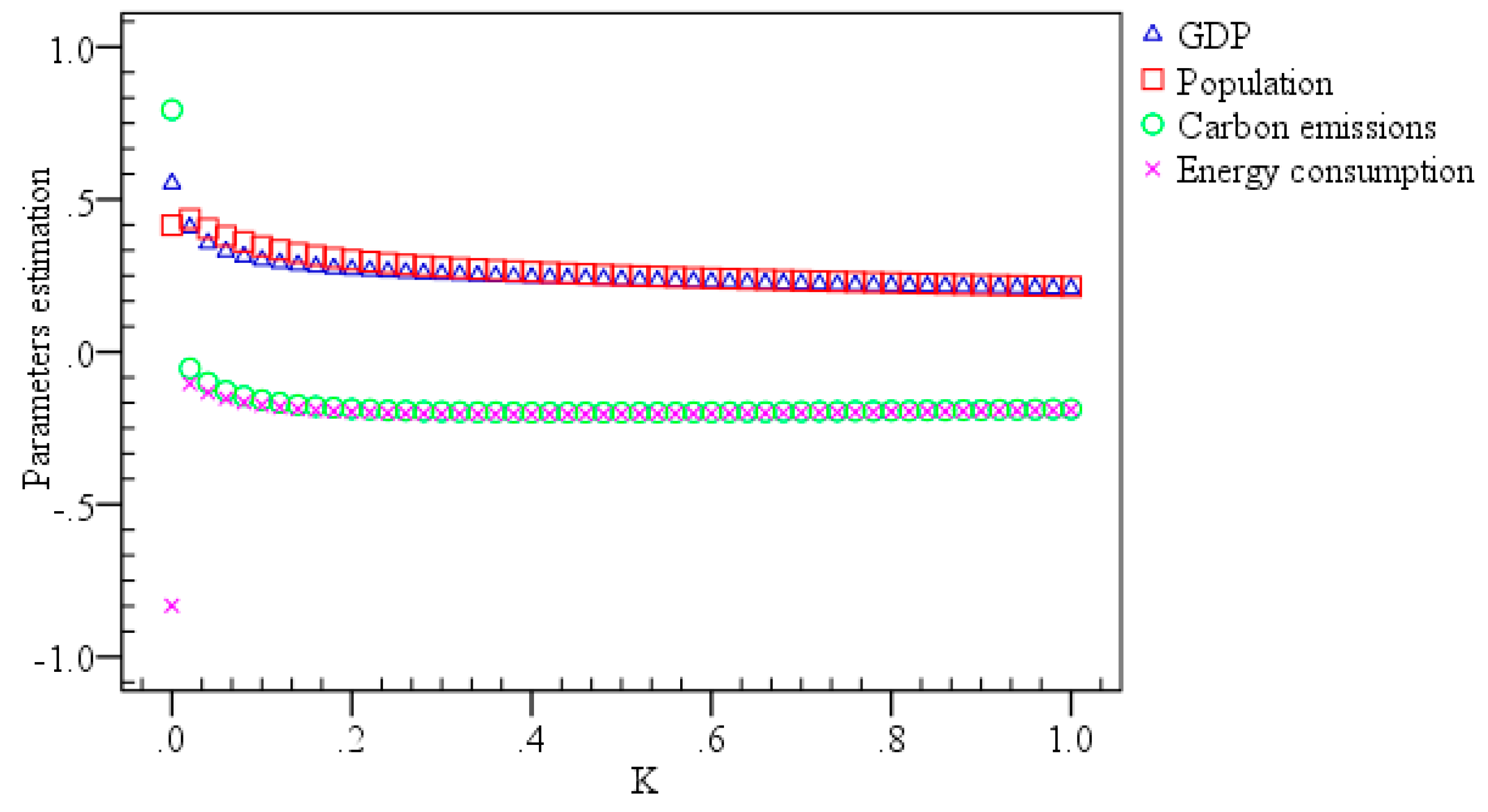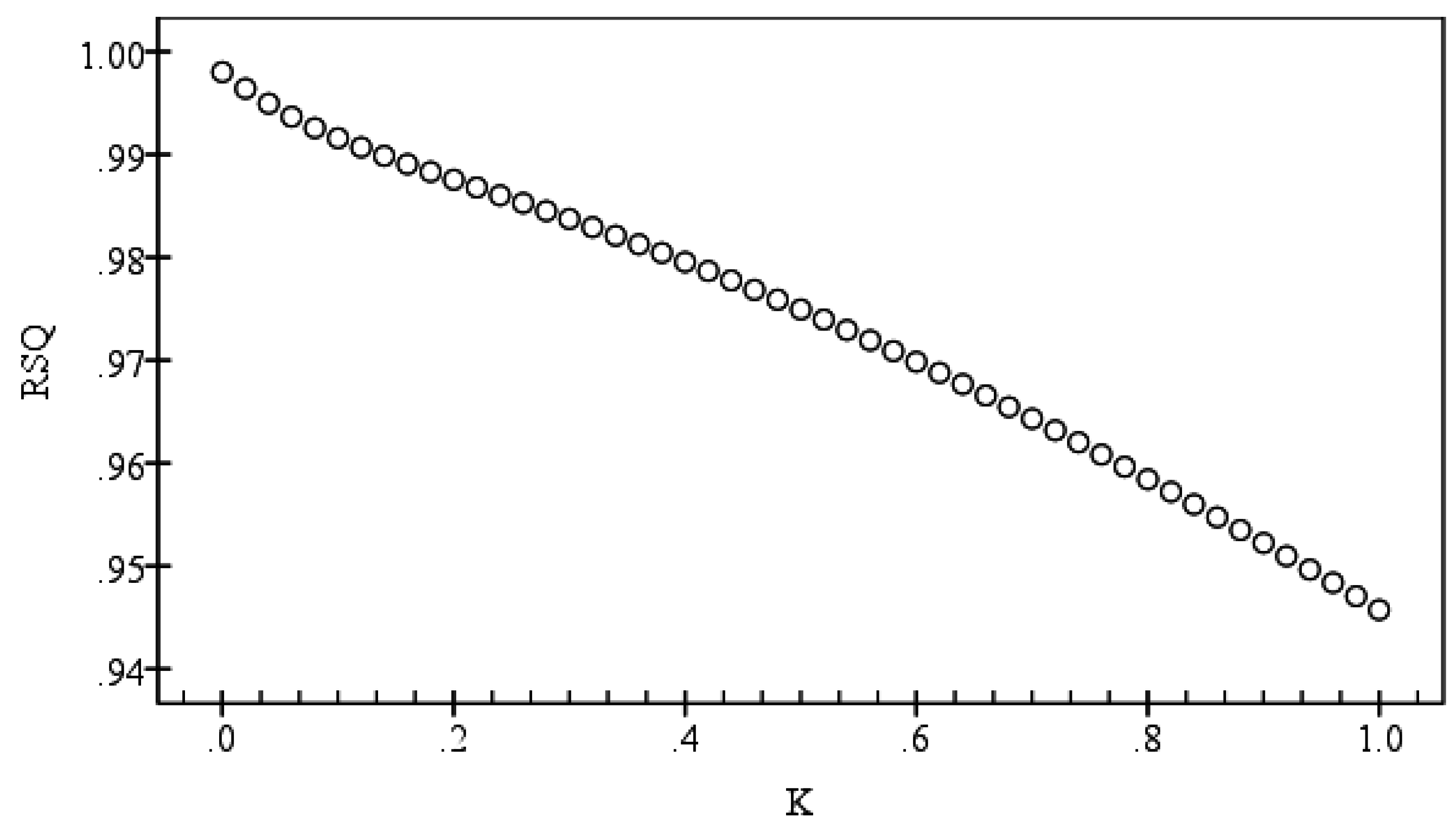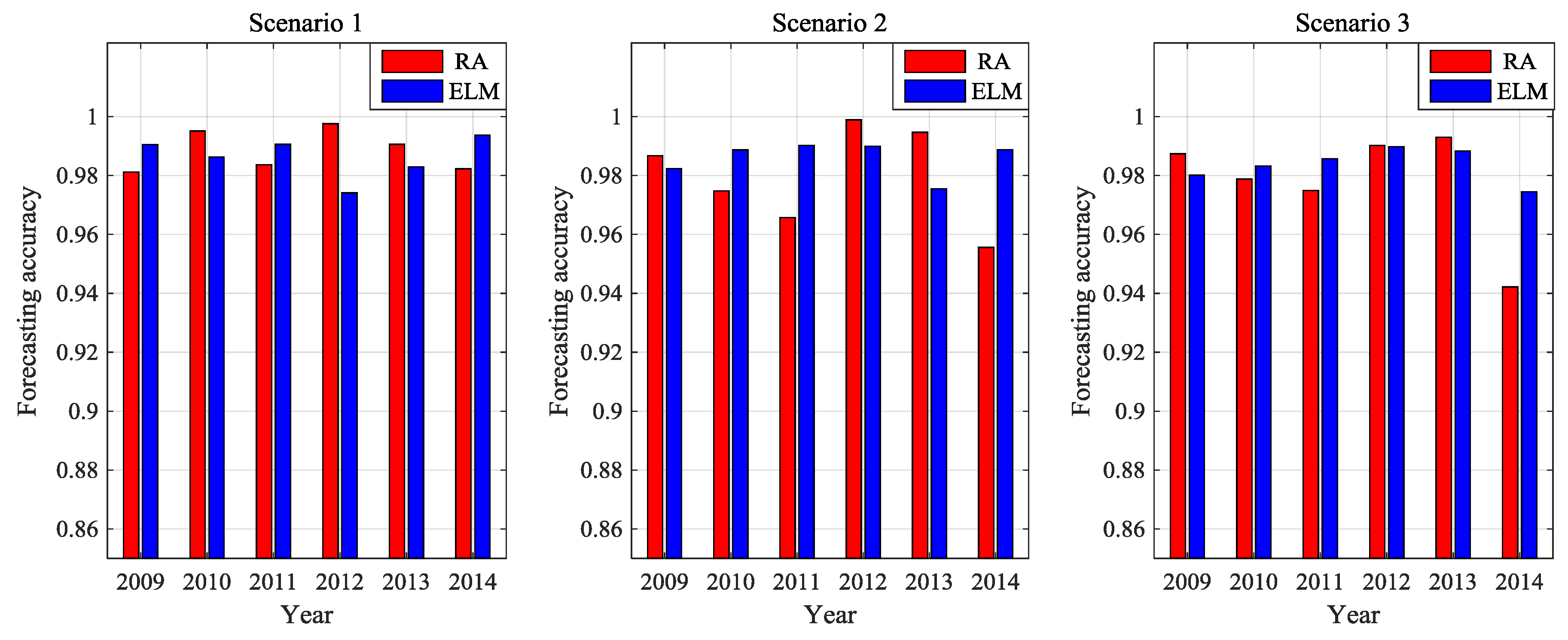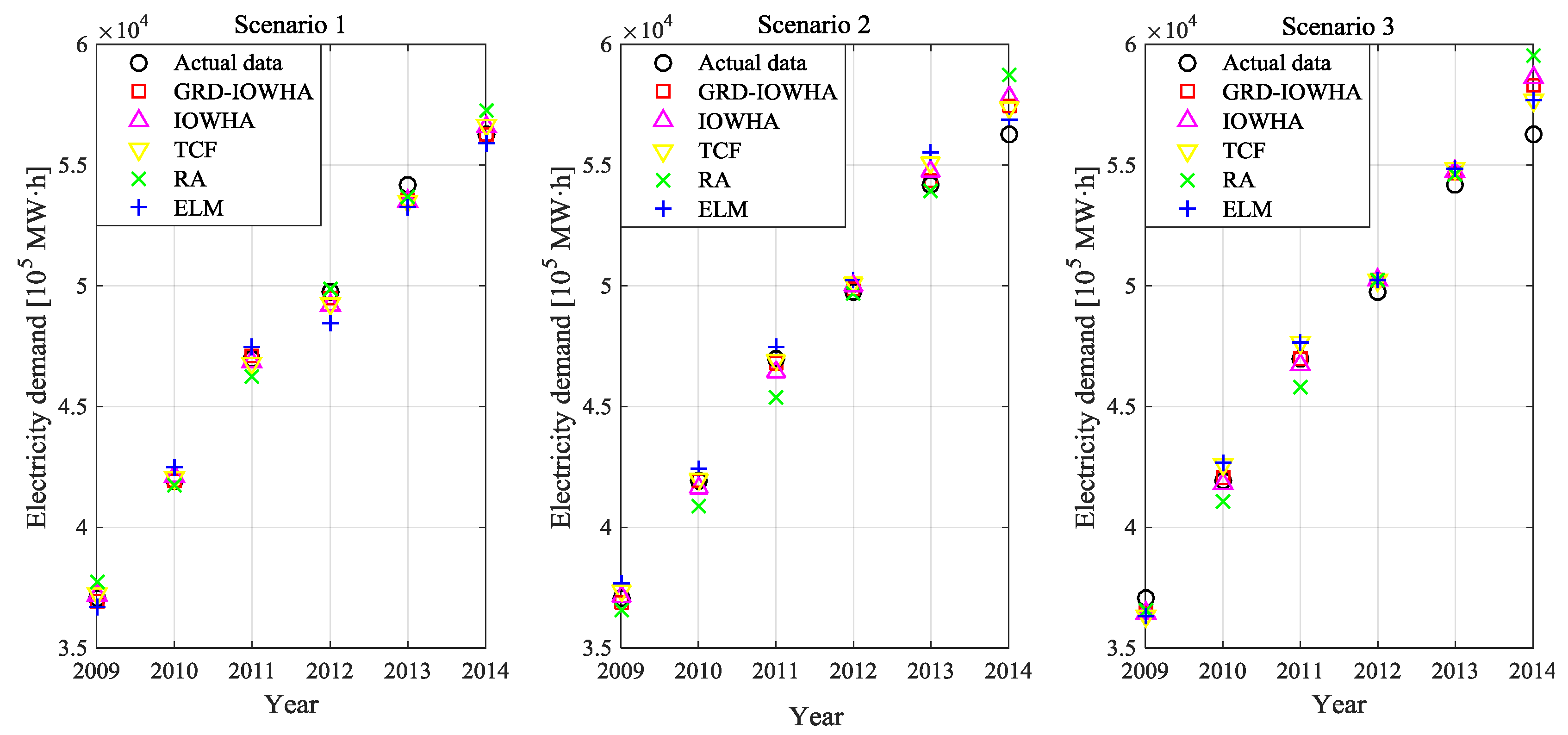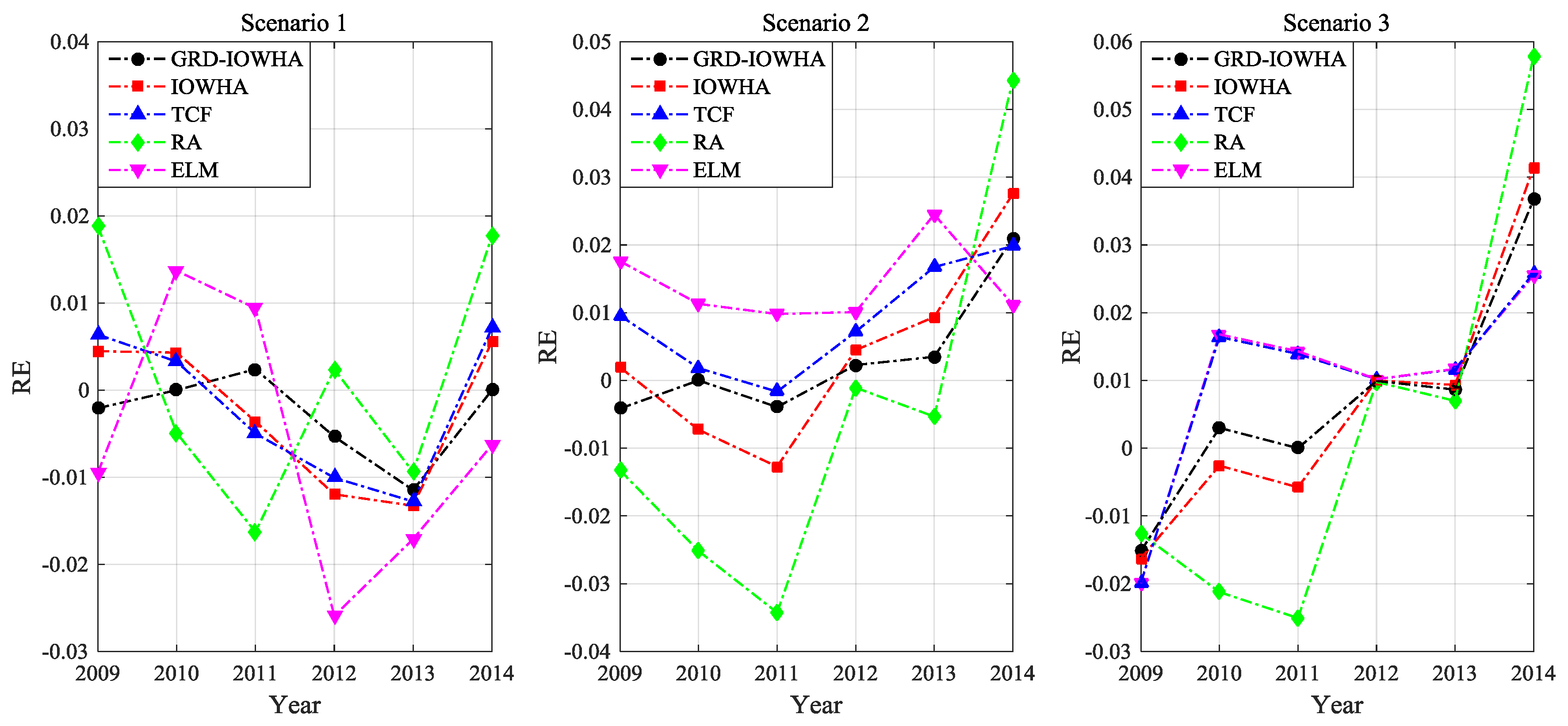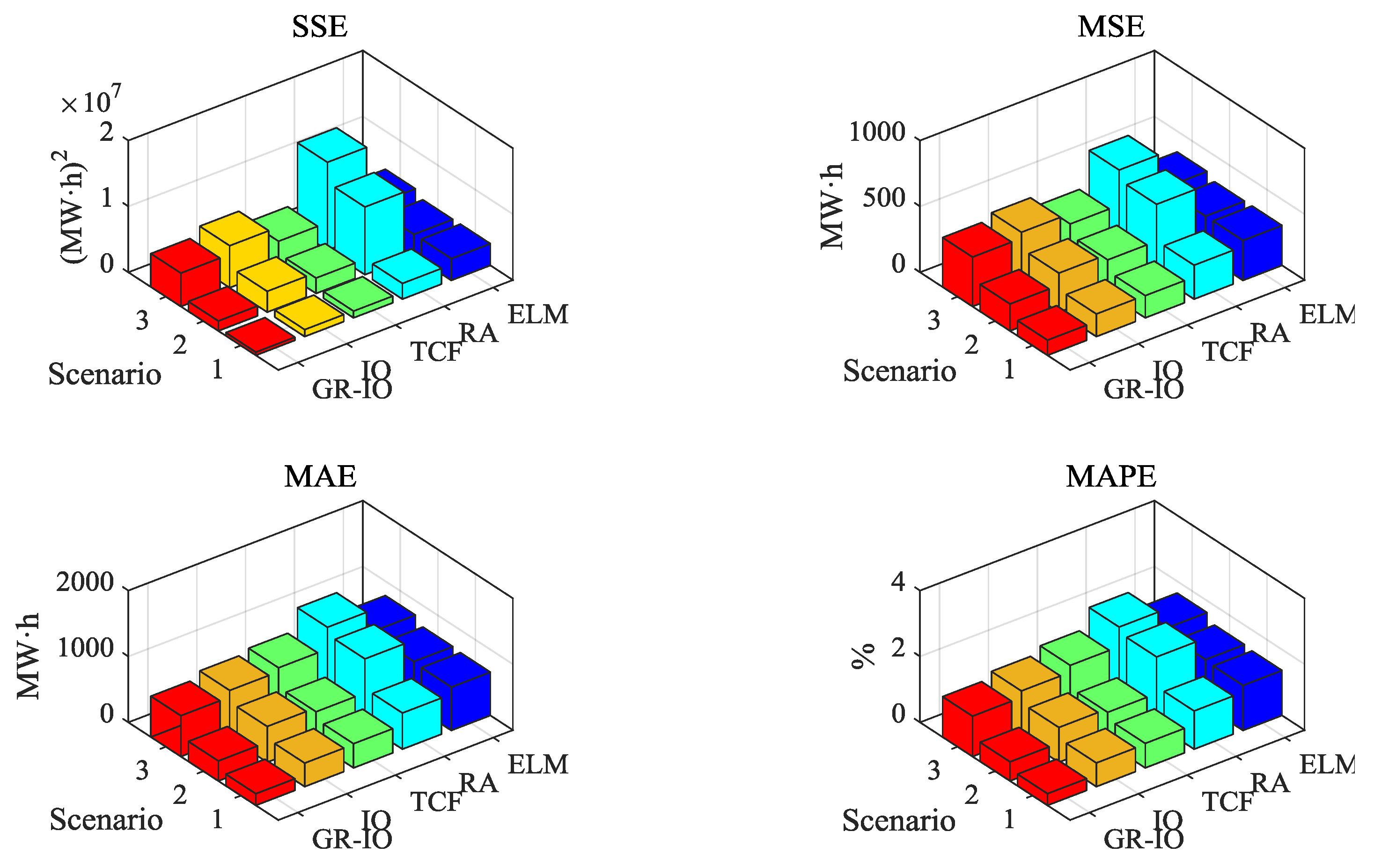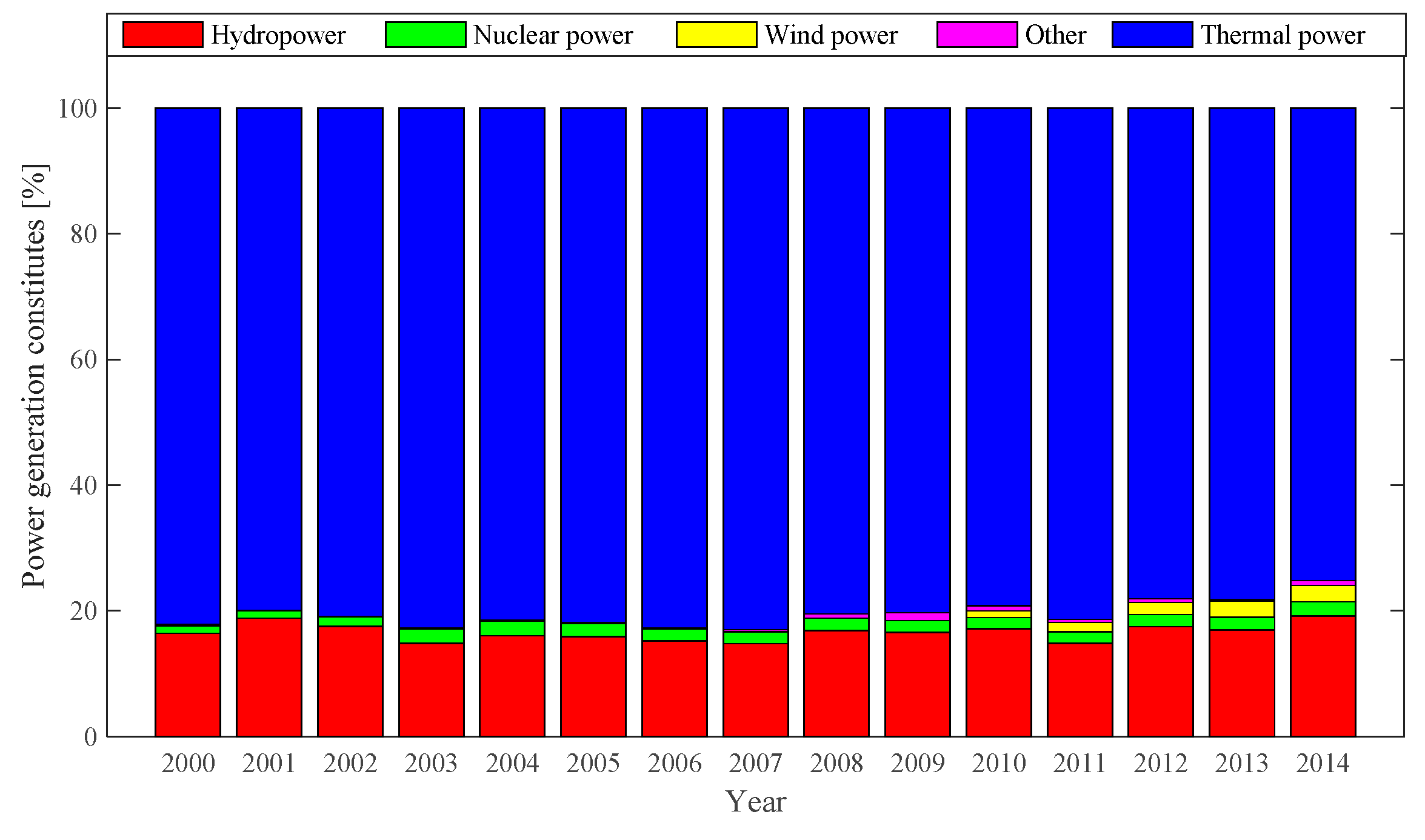1. Introduction
As one of the leading pioneers of national economy advancement, the electricity sector shoulders the responsibility of ensuring a stable electricity consumption and economic expansion rapidly at home and abroad [
1]. Relevant to the characteristics of the electric power commodity, such as instantaneous production, transport and consumption as well as non-storability, future power demand prediction seems imperative and inevitably required. Accordingly, such sort of prediction is beneficial to the entire electricity development planning process by allowing scientifically and timely adjustment of power demand variation conditions towards sustainability [
2].
With the increasing attention to climate change and greenhouse gas (GHGs) emission abatement worldwide, China has initially attempted to extend a low-carbon economy pattern, namely in the pursuit of adoption of technical progress and institutional innovation to transform energy utilization patterns, enhance energy efficiency and optimize the energy sector structure [
3]. Among GHGs forms, CO
2 is on the top of list, accounting for 77% of global warming potential [
4]. In China, CO
2 emissions generated by fossil energy consumption not only account for approximately 80% of total global greenhouse emissions, but also account for more than two-thirds of the responsibility for adverse greenhouse effect [
5,
6]. This adverse effect is representative and deteriorates seriously China’ electricity sector. Regarding this, China has taken considerable countermeasures to address low-carbon issues, like climate deterioration, late environmental-protection starting of power sectors and so forth. In 2007, “Energy Saving Generation Dispatching” was published to decrease the carbon emission coefficient mainly caused by the thermal power structure [
7]. Since 2013, much focus been placed on the emission-reducing effects of renewable energy sources, like zero release terms, and the National Development and Reform Commission (NDRC) in China has issued the so-called “12th five-year plan of renewable energy development” to further raise the proportion of renewable energy sources in the energy consumption mix to 15% [
8] by 2020. As the largest emission-cutting participant in the clean development mechanism (CDM), China has obtained large emissions reductions from zealous participation and introduction of low-carbon technology and funds, whose checked emission reduction (CERs) reached 50% of the global share [
9]. Generally, electricity demand forecasting research from the perspective of low-carbon economy proves much practical significance and practical value.
Currently, in the existing macroeconomic background, both domestic and international, numerous countries have selected appropriate variables and models to forecast electricity demand, such as Italy [
10], Spain [
11], USA [
12], Brazil [
13], Japan [
14], Singapore [
15], Thailand [
16] and Indonesia [
17]. In general, electricity demand forecasting methods can be decomposed into two aspects, namely traditional forecasting models and modern intelligent forecasting models. When it comes to traditional forecasting models, time series [
18,
19,
20], regression analysis [
21], Gray forecasting [
22], fuzzy forecasting [
23], index decomposition method [
24] and so forth, are implemented widely. Pappas et al. [
19,
20] applied auto regressive moving average (ARMA) model to model the electricity demand loads in Greece, respectively using the Akaike corrected information criterion (AICC) and multi-model partitioning algorithm (MMPA). Hussain et al. [
18] integrated Holt-winter with autoregressive integrated moving average (ARIMA) models on time series secondary data covering 1980–2011 in Pakistan, to predict overall and segmental electricity consumption. García and Carcedo [
21] present an alternative analysis of electricity demand, on the basis of a simple growth rate decomposition scheme that allows vital factors behind this evolution to be identified. Similarly, Torrini et al. [
22] employed the extended properties of fuzzy logic methodology to forecast the long-run electricity consumption in Brazil; while Zhao et al. [
23] recommended an improved GM (1,1) model using Inner Mongolia as object. Further, multiple linear regression analysis and a quadratic regression analysis were performed deeply by Fumo et al. [
24] on hourly and daily data from a research house. Inevitably, these traditional models have been comparatively proved to display a simple range of application and low-accuracy prediction thorough validated tools and simplified calculation. As for modern intelligent forecasting models, Günay [
25] proposed artificial neural networks to forecast annual gross electricity demand using predicted values of social-economic indicators and climatic conditions. Son and Kim [
26] applied support vector regression with particle swarm optimization algorithms to forecast the residential sector's electricity demand. Modern intelligent forecasting models have demonstrated excellent performance, including simplified regression course, transformation inference realization from training samples to predicted samples as well as avoidance towards the traditional process from induction to deduction [
27]. However, they are easily trapped in over-fitting, local optima and so on. As a new type of single-hidden layer feedforward neural network primarily proposed by Huang et al. [
28], extreme learning machine (ELM) embodies the features of adaptive ability, autonomic learning and optimal computation needed for unstructured and imprecise disciplines. Only by designing the suitable hidden layer nodes before training, bestowing value on input weight and partial hidden layer randomly in process, as well as simultaneously fulfilling at once without iterative, a sole optimum solution will be obtained.
Various forecasting models vary greatly from the perspective of distinct points to reflect economic variation tendencies, thus strengthening the weakness of lower accuracy using a single forecasting model. It was Bates and Granger [
29] who firstly advocated combination forecasting approaches in 1969, and since then a considerable volume of studies have been conducted in many fields by domestic and overseas scholars [
30,
31,
32]. The essence of combined forecasting is to solve the weighted average of single forecasting models. However, existing traditional combination forecasting models have fallen into a paralogism, namely different single forecasting models with distinguished weight coefficients, while constant combination models have unchanged weight coefficient [
33]; in reality, the weight coefficient of a single forecasting model is supposed to be a function of time. Problems posed by traditional thought, are comprehensively conquered by the establishment of IOWHA operator-based forecasting models [
34] in a concept of distinguished weight coefficients with the same single forecasting model over time [
34,
35]. Furthermore, the forecasting accuracy of the IOWHA operator shows an overdependence on the reciprocal error sum of squares which similarly is influenced by outliers to magnify the errors. Regarding this, the relevant properties of the grey relation degree (GRD) were devised and integrated with the IOWHA operator such as robust index combination, including dominance combination forecasting, non-pessimum forecasting and redundancy degree [
36].
Hence, based on previous literature, a new framework of combination forecasting electricity demand model is characterized as follows: firstly, integration of GRD with the IOWHA operator to propose a new weight determination method of combination forecasting model on the basis of forecasting accuracy as induced variables; secondly, utilization of the proposed weight determination method to construct the optimal combination forecasting model based on the ELM forecasting model and multiple regression model; thirdly, three scenarios in line with the realization level of various low-carbon economy targets and dynamic simulation of the effects of low-carbon economy on future electricity demand. The remainder of this paper is organized as follows:
Section 2 discusses low-carbon target scenario setting. In
Section 3, a new combined GRD-IOWHA operator forecasting model is proposed.
Section 4 and
Section 5 discuss the combination forecasting model and model results of electricity demand in China, respectively. Overall conclusions are summarized in
Section 6.
5. Results and Discussions
Deduced from China’s electricity demand forecasting results under various scenarios, further discussion is concluded from four perspectives.
(1) GRD-IOWHA operator-based combination forecasting model outperformed each single forecasting model notably.
Figure 8 demonstrates the forecasting accuracy comparison of single forecasting models covering testing data in 2009–2014, where Scenario 1 means baseline scenario, Scenario 2 represents the low-carbon scenario and Scenario 3 in the intensified low-carbon scenario. Single forecasting models provide various forecasting accuracy at various moments. More specifically, in the baseline scenario, the ELM model shows a superior forecasting accuracy of electricity demand than the RA model in 2009, 2011 and 2014; while the RA model is much better in 2010, 2012 and 2013. In the low-carbon scenario, the RA model provides better forecasting accuracy than the ELM model, namely 2009, 2012 and 2013; while the ELM model predicts electricity demand overwhelmingly in other years (2010, 2011 and 2014). In the intensified low-carbon scenario, the RA model provides higher forecasting accuracy in 2009, 2012 and 2013 and lower forecasting accuracy in 2010, 2011 and 2014. Generally, the proposed GRD-IOWHA operator-based combination forecasting model concentrates the advantages of various single forecasting models, namely higher weight coefficient in higher single forecasting accuracy and vice versa. According to Equations (20) and (21),
Table 12 represents grey relation degree comparison, from 2009 to 2014, in various scenarios between single forecasting model and GRD-IOWHA operator-based combination forecasting model. Findings show that grey relation degree of three scenarios in GRD-IOWHA operator-based combination forecasting model is better than that of single forecasting models. Thus, the proposed combination model belongs to the dominated forecasting combination model [
36].
(2) The proposed GRD-IOWHA operator-based combination forecasting model predicts accurately and more truly than the basic IOWHA operator-based combination forecasting model [
35] and the traditional combination forecasting (TCF) model [
33], namely each single forecasting model with unchanged weight coefficient. In order to compare typical combination forecasting models effectively, this section compares the measured IOWHA operator-based combination forecasting model and traditional combination models shown in
Table 13.
According to the evaluating principle of forecasting effect, the following dimensions are selected as the evaluation index system, including
RE,
SSE,
MSE,
MAE,
MAPE,
MSPE. Concretely, only
RE is used to reflect single forecasting model effect.
Figure 9 illustrates electricity demand forecasting in 2009–2014 using GRD-IOWHA operator-based combination forecasting model, IOWHA operator-based combination forecasting model and traditional combination forecasting model separately:
where
xt denotes the actual demand value, presents the predicted value.
Compared with the other forecasting models, the proposed GRD-IOWHA operator-based combination forecasting model is rather close to actual values. From
Figure 10, under the distinguished scenario, the relative error value of the proposed GRD-IOWHA operator-based combination forecasting model is in much lower interval and fluctuates slightly, followed by IOWHA operator-based combination forecasting model or traditional combination forecasting model, worst in two single forecasting model. In a word, proposed GRD-IOWHA operator-based combination forecasting model perform more superiority in decreasing forecasting error fluctuation and risk of tech-economic decision making. Furthermore,
Figure 11 demonstrates the overall forecasting evaluation result of various forecasting model, especially being satisfactory and optimal condition in index
SSE,
MSE,
MAE and
MAPE. Yet exceptional situations still exist, like lower
SSE and
MSE in a traditional forecasting model than the GRD-IOWHA operator-based combination forecasting model under intensified low-carbon scenario due to larger forecasting error caused by single forecasting models. In spite of this, the proposed combination forecasting model outperformed both in effectiveness and feasibility as a whole.
(3) Low-carbon economy advancement contributes to augment electricity demand in China. Known from
Figure 12, electricity demand under energy restriction, i.e., low-carbon scenario and intensified low-carbon scenario, is greater than that under unrestricted energy use. Hence, China will strive to cut down the utilization of high-emission releasing resources, like coal, oil, natural gas and so on as well as explore the substituent effect of electricity. Under energy restriction circumstances, electricity demand in an unchanged energy efficiency scenario is higher than that of continually improved energy efficiency, thus emission-cutting emphasis lies in energy structure optimization and electricity demand increasing. However, if China initially promises a lower energy efficiency (energy consumption per GDP), like 15% declining by 2020 rather in 2015, pressure on China’s electricity demand will be cut down tremendously.
(4) A low-carbon economy causes a structural variation of electricity demand. Increasing electricity demand is mainly involved in renewable clean energy, like water power, nuclear power and wind power. With respect to a low-carbon scenario, i.e., unchanged energy efficiency, incremental 72.0263 million MW·h electricity demand is also chiefly centralized in renewable clean energy electricity demand compared with the baseline scenario. Despite the continuous effort on electricity structure adjustment and decreasing the ratio of coal power, the coal power ratio will not fall sharply for a time behind the reason of over-dependence on electricity and abundant coal resources. Illustrated in baseline scenario of
Figure 13, power generation is presumed to be 70% coal power ratio and 30% in water power, nuclear power and wind power, which accounts for 238.5022 million MW·h in 2020. Due to the constrained energy policy, under the unchanged energy efficiency situation, electricity demand from clean energy approaches nearly 2601.1011 million MW·h by 2020, which accounts for 32.72% of total electricity demand, while the coal power ratio decreased to 67.28%. Therefore, the low-carbon economy has affected both electricity demand and its structure variation.
